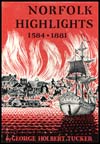Chapter 34
The Norfolk-Portsmouth Ferries
The Gosport, a "neat and handsome vessel," built in Portsmouth and outfitted with her engine in Philadelphia, was the first steam ferry to run between Norfolk and Portsmouth. She made her first trips across the harbor in 1832, taking five minutes, then considered a fast trip, to navigate from wharf to wharf.
At that time, however, Norfolk already had a ferry history dating from 1636, when Captain Adam Thoroughgood had set up the first convenience of its sort south of Hampton Roads, using a crude, hand-rowed skiff to replace the hit-or-miss log canoe navigation of the Indians.
The appearance of the Gosport in Norfolk harbor established a tradition of regular service that was terminated one hundred and twenty-three years later on August 31, 1955. Ferry service between Norfolk and Portsmouth was restored once more in 1983.
Before the coming of steam, the Norfolk-Portsmouth ferries were first serviced by man-powered boats, and later with larger craft equipped with paddle wheels driven by blind mules or horses on a treadmill. During the latter period, according to tradition, the man who leased the ferries made a point to hire only one-legged men to row the boats. On one occasion when a persistent two-legged man kept insising on being given a job, the ferry captain got rid of him by grabbing a saw and making a dive for the applicant's right leg. At that point, the insistent seeker of employment sought a job elsewhere.
Once the puffing old tubs took over the harbor, many colorful events took place that contributed greatly to the folklore of the Norfolk area.
Shortly after steam replaced manpower, mulepower, and horsepower on the ferry run, an unsuspecting Norfolk area citizen, according to tradition, wound up wishing that he hadn't been so curious. Mistaking a brass-bound exhaust pipe projecting from the wall of one of the Gosport's successors as a speaking tube, he carried on a one-way conversation until a gush of steam from the boiler room resulted in his being presented with a set of false teeth by the ferry officials.
Then there was the Manahassett, a popular side-wheeler that was known as the "Mammy Ferry." The upper deck of this boat was enclosed in lattice work, making it a safe place for children to play while riding across the harbor.
Every sunny summer afternoon while the Manahassett was plying the harbor, her upper deck was reserved for Norfolk area nursemaids. And after the gate leading to the upper deck had been locked by a deckhand, they would settle down for a leisurely gossip in the checquered sunlight while their charges romped all over the upper deck for an inclusive fare of twenty-five cents per party for the entire afternoon.
There was also the Confederate flag incident which took place when the Federal forces were operating the ferries from 1862 to 1865. Hoping to humiliate the Confederate sympathizers in Norfolk and Portsmouth, some of the soldiers guarding the Portsmouth ferry terminal stretched the Stars and Bars across the floor at the entrance of the ticket booth.
During the ensuing melee, a loyal Southern girl snatched up the flag, secreted it in her muff, and escaped before she could be apprehended.
One of the best stories concerning the old ferriers, however, dates from the early 1850s, when a male passenger strenuously objected in the press to the obscene drawings and graffiti he found on the waiting room walls during his crossings of the harbor. Taking the hint, the ferry management promised to have the room whitewashed every week. But it also added a footnote for the benefit of the prudish bellyacher:
"Go into the waiting room and sit quietly down," it admonished, "not wasting your time reading the scribbling on the wall."
Chapter
35
The Making of a Shrine
Norfolk Highlights 1584 - 1881

See the "Table of Contents" for links to every chapter in Norfolk Highlights 1584 - 1881 by George Holbert Tucker.
